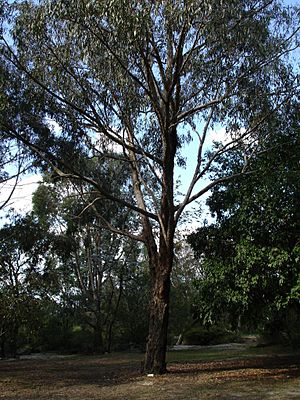Long-leaved box facts for kids
Quick facts for kids Long-leaved box |
|
|---|---|
 |
|
| Eucalyptus goniocalyx in Maranoa Gardens, Melbourne | |
| Scientific classification | |
| Genus: |
Eucalyptus
|
| Species: |
goniocalyx
|
 |
|
| Eucalyptus goniocalyx, field distribution | |
| Synonyms | |
|
|
The Long-leaved Box (scientific name: Eucalyptus goniocalyx) is a type of tree found only in southeastern Australia. People also call it the Olive-barked Box or Bundy. It's usually a small to medium-sized tree.
This tree has bark that feels rough, like fibers or flakes. Its adult leaves are shaped like a spear or are slightly curved. When it blooms, its flower buds grow in groups of seven. The flowers are white, and its fruit looks like a cup, cylinder, or barrel.
Contents
What the Long-leaved Box Looks Like
The Long-leaved Box tree typically grows up to 15 m (49 ft) (about 50 feet) tall. It has a special woody swelling at its base called a lignotuber. This helps the tree regrow if it gets damaged, like by a bushfire.
Its bark is usually rough and grayish. The exact thickness and feel of the bark can change depending on the specific type of Long-leaved Box.
Leaves and Flowers
Young Long-leaved Box plants have round leaves that are 35–110 mm (1.4–4.3 in) (1.4-4.3 inches) long and 35–100 mm (1.4–3.9 in) (1.4-3.9 inches) wide. These leaves grow directly from the stem in opposite pairs.
As the tree gets older, its adult leaves become longer and narrower, about 60–250 mm (2.4–9.8 in) (2.4-9.8 inches) long and 13–40 mm (0.51–1.57 in) (0.5-1.6 inches) wide. They grow on a small stalk called a petiole, which is 10–40 mm (0.39–1.57 in) (0.4-1.6 inches) long.
The flower buds grow in groups of seven. Each group is on a stalk called a peduncle, which is 5–15 mm (0.20–0.59 in) (0.2-0.6 inches) long. The buds themselves are usually attached directly to this stalk without their own tiny stems.
Mature buds are oblong or oval, about 6–11 mm (0.24–0.43 in) (0.2-0.4 inches) long and 4–7 mm (0.16–0.28 in) (0.2-0.3 inches) wide. They have a cap-like lid called an operculum, which can be cone-shaped or rounded.
The Long-leaved Box blooms between March and August, showing off its white flowers. After flowering, it produces woody fruits. These fruits are like capsules, shaped like a cup, cylinder, or barrel. They are 5–10 mm (0.20–0.39 in) (0.2-0.4 inches) long and 6–11 mm (0.24–0.43 in) (0.2-0.4 inches) wide.
Naming the Long-leaved Box
The scientific name Eucalyptus goniocalyx was first officially written down in 1856. This was done by Friedrich Miquel, using notes from another scientist, Ferdinand von Mueller.
Later, in 1997, a scientist named Dean Nicolle found two different types, or subspecies, of Eucalyptus goniocalyx. Then, in 2011, Kevin Rule found three more subspecies. All five of these types are now recognized.
Different Types of Long-leaved Box
Here are the five accepted subspecies:
- Eucalyptus goniocalyx subsp. exposa D.Nicolle: This type is a mallee, which means it's a shrubby tree with multiple stems. It has smooth bark or thinner rough bark. Its adult leaves are small, and its young branches, buds, and fruit have a waxy coating.
- Eucalyptus goniocalyx subsp. fallax Rule: This subspecies has thin, light brown, fibrous bark that might look smooth. Its young leaves are a dull blue-green color.
- Eucalyptus goniocalyx F.Muell. ex Miq. subsp. goniocalyx: This is the most common type. It has thick, often crusty, scaly bark that even extends to its thinner branches. Its young leaves are also a dull blue-green.
- Eucalyptus goniocalyx subsp. laxa Rule: This type only has rough bark on the lower part of its trunk. The bark higher up is smooth and not fibrous, and it's loosely attached.
- Eucalyptus goniocalyx subsp. viridissima Rule: You can tell this subspecies apart by its shiny, bright green young leaves.
What the Names Mean
The name goniocalyx comes from two Greek words: gonia meaning 'angle' and calyx which refers to the flower bud.
- Exposa is an English word, meaning 'exposed'. This subspecies grows in open, exposed places.
- Fallax comes from Latin and means 'false' or 'deceitful'. This refers to how its bark can look smooth even though it's fibrous.
- Laxa is from the Latin word laxus, meaning 'loose'. This describes its loosely attached bark.
- Viridissima combines the Latin word viridis (green) with the suffix issimus (very). So, it means 'very green', referring to its bright green young leaves.
Where the Long-leaved Box Lives
The different subspecies of Long-leaved Box grow in various parts of southeastern Australia:
- Subspecies goniocalyx is very common. It grows in woodlands, often on hilly, rocky ridges. You can find it south of Mudgee in New South Wales and across central Victoria. There are also some groups of these trees in southeastern South Australia.
- Subspecies exposa is found only in the Elder Range and Wilpena Pound areas. It grows on the tops of mountains, sometimes with another tree called E. flindersii.
- Subspecies fallax is only known from one place: a forest south of Mount Blackwood, near Greendale in central Victoria.
- Subspecies laxa prefers well-watered, heavy soil. It grows in the Brisbane Ranges National Park.
- Subspecies viridissima grows in scattered areas in Victoria, like in the Grampians and Halls Gap regions.
Uses of the Long-leaved Box
Essential Oils
The leaves of the Long-leaved Box are used to make eucalyptus oil. This oil is rich in a substance called cineole, which is used in many products, including medicines and cleaning supplies.
See also
 In Spanish: Boj de hojas largas para niños
In Spanish: Boj de hojas largas para niños

